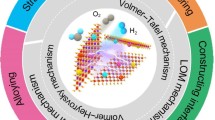Much of the research by Konrad Hayek’s group is focused on the influence of oxide–metal interfaces in heterogeneous catalysis. In this paper, we show that electronic excitations at the metal surface induced by exothermic catalytic reactions lead to the generation of energetic (hot) electron flows. We detected the flow of hot electrons during oxidation of carbon monoxide using Pt/TiO2 Schottky diodes. The thickness of the Pt film used as the catalyst was 5 nm, less than the electron mean free path, resulting in the ballistic transport of hot electrons through the metal. The electron flow was detected as a chemicurrent if the excess electron kinetic energy generated by the exothermic reaction was larger than the effective Schottky barrier formed at the metal-semiconductor interface. We found that heat generated by the reaction caused a negligible increase of temperature in our experimental range, suggesting that this thermal effect is not responsible for the generation of hot electron flow. We tested the stability and reversibility of chemicurrent generated during CO oxidation at 413~573 K. The activation energy calculated from the measurement of chemicurrent is quite close to that of the turnover rate of chemical reaction, which indicates that the generation mechanism of hot electrons is closely correlated with the chemical reaction. This correlation suggests that hot electron flow could be a new tool to probe the role of oxide–metal interfaces in heterogeneous catalysis.
Similar content being viewed by others
References
G.M. Schwab R. Siegert (1966) Zeitschrift Fur Physikalische Chemie-Frankfurt 50 191 Occurrence Handle1:CAS:528:DyaF28XkvVGqtb8%3D
G.M. Schwab (1967) Angewandte Chemie-International Edition 6 375
S.J. Tauster S.C. Fung R.L. Garten (1978) J. Am. Chem. Soc. 100 170–175 Occurrence Handle10.1021/ja00469a029 Occurrence Handle1:CAS:528:DyaE1cXms1ejsg%3D%3D
S. Penner D. Wang R. Podloucky R. Schlogl K. Hayek (2004) Phys. Chem. Chem. Phys. 6 5244–5249 Occurrence Handle10.1039/b410124c Occurrence Handle1:CAS:528:DC%2BD2cXpsFKrs7s%3D
G. Rupprechter G. Seeber H. Goller K. Hayek (1999) J. Catal. 186 201–213 Occurrence Handle10.1006/jcat.1999.2555 Occurrence Handle1:CAS:528:DyaK1MXls1eitLg%3D
K. Hayek M. Fuchs B. Klotzer W. Reichl G. Rupprechter (2000) Topics in Catalysis 13 55–66 Occurrence Handle10.1023/A:1009072519733 Occurrence Handle1:CAS:528:DC%2BD3cXms1Gis7Y%3D
A. Boffa C. Lin A.T. Bell G.A. Somorjai (1994) J. Catal. 149 149–158 Occurrence Handle10.1006/jcat.1994.1280 Occurrence Handle1:CAS:528:DyaK2cXmtVyjsr8%3D
G.L. Haller D.E. Resasco (1989) Advances in Catalysis 36 173–235 Occurrence Handle1:CAS:528:DyaL1MXlsVWnsbo%3D Occurrence Handle10.1016/S0360-0564(08)60018-8
L. Hellberg J. Stromquist B. Kasemo B.I. Lundqvist (1995) Phys. Rev. Lett. 74 4742–4745 Occurrence Handle10.1103/PhysRevLett.74.4742 Occurrence Handle1:CAS:528:DyaK2MXmtFSgu7k%3D
Y.H. Huang C.T. Rettner D.J. Auerbach A.M. Wodtke (2000) Science 290 111–114 Occurrence Handle10.1126/science.290.5489.111 Occurrence Handle1:CAS:528:DC%2BD3cXnt1ejsb4%3D
J.W. Gadzuk (2002) J. Phys. Chem. B 106 8265–8270 Occurrence Handle10.1021/jp025761y Occurrence Handle1:CAS:528:DC%2BD38XksVKnt7k%3D
J.R. Trail M.C. Graham D.M. Bird M. Persson S. Holloway (2002) Phys. Rev. Lett. 88 166802 Occurrence Handle10.1103/PhysRevLett.88.166802 Occurrence Handle1:CAS:528:DC%2BD38XivVajsLg%3D
M.S. Mizielinski D.M. Bird M. Persson S. Holloway (2005) J. Chem. Phys. 122 084710 Occurrence Handle10.1063/1.1854623 Occurrence Handle1:CAS:528:DC%2BD2MXitVGgs7k%3D
D.N. Denzler C. Frischkorn C. Hess M. Wolf G. Ertl (2003) Phys. Rev. Lett. 91 226102 Occurrence Handle10.1103/PhysRevLett.91.226102 Occurrence Handle1:CAS:528:DC%2BD3sXptlGgsbk%3D
B.R. Trenhaile V.N. Antonov G.J. Xu K.S. Nakayama J.H. Weaver (2005) Surface Science 583 L135–L141 Occurrence Handle1:CAS:528:DC%2BD2MXktFWhtbw%3D
H. Nienhaus (2002) Surface Science Reports 45 3–78 Occurrence Handle10.1016/S0167-5729(01)00019-X
H. Nienhaus H.S. Bergh B. Gergen A. Majumdar W.H. Weinberg E.W. McFarland (1999) Phys. Rev. Lett. 82 446–449 Occurrence Handle10.1103/PhysRevLett.82.446 Occurrence Handle1:CAS:528:DyaK1MXit12mtA%3D%3D
R. Konenkamp (2000) Phys. Rev. B 61 11057–11064 Occurrence Handle10.1103/PhysRevB.61.11057 Occurrence Handle1:CAS:528:DC%2BD3cXis1amtro%3D
R. Konenkamp I. Rieck (2000) Materials Science and Engineering B-Solid State Materials for Advanced Technology 69 519–521
J.Y. Park G.A. Somorjai (2006) J. Vac. Sci. Technol.B 24 1967–1971 Occurrence Handle10.1116/1.2218861 Occurrence Handle1:CAS:528:DC%2BD28XnvVajsrg%3D
J.Y. Park G.A. Somorjai (2006) Chem Phys Chem 7 1409–1413 Occurrence Handle1:CAS:528:DC%2BD28Xnt1Olur8%3D
X.Z. Ji G.A. Somorjai (2005) J. Phys. Chem. B 109 22530–22535 Occurrence Handle10.1021/jp054163r Occurrence Handle1:CAS:528:DC%2BD2MXhtFKrt7jI
R. Schaub E. Wahlstrom A. Ronnau E. Laegsgaard I. Stensgaard F. Besenbacher (2003) Science 299 377–379 Occurrence Handle10.1126/science.1078962 Occurrence Handle1:CAS:528:DC%2BD3sXjsF2ktw%3D%3D
H. Iddir M.M. Disko S. Ogut N.D. Browning (2005) Micron 36 233–241 Occurrence Handle10.1016/j.micron.2004.12.002 Occurrence Handle1:CAS:528:DC%2BD2MXhs12hsLY%3D
H. Iddir S. Ogut N.D. Browning M.M. Disko (2005) Physical Review B 72 081407 Occurrence Handle10.1103/PhysRevB.72.081407 Occurrence Handle1:CAS:528:DC%2BD2MXhtVWqu77L
G.A. Somorjai K.M. Bratlie M.O. Montano J.Y. Park (2006) J. Phys. Chem. B 110 20014–20022 Occurrence Handle10.1021/jp062569d Occurrence Handle1:CAS:528:DC%2BD28XntFKks7g%3D
Author information
Authors and Affiliations
Corresponding author
Rights and permissions
About this article
Cite this article
Park, J.Y., Renzas, J.R., Contreras, A.M. et al. The genesis and importance of oxide–metal interface controlled heterogeneous catalysis; the catalytic nanodiode. Top Catal 46, 217–222 (2007). https://doi.org/10.1007/s11244-007-0331-7
Issue Date:
DOI: https://doi.org/10.1007/s11244-007-0331-7




